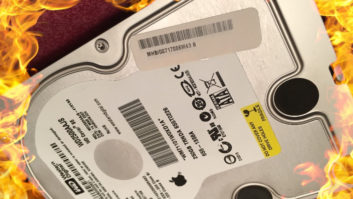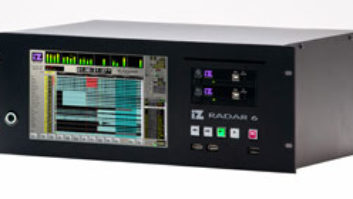When media theorist Marshall McLuhan published his landmark The Medium is the Message in 1967, he wasn’t talking about recording media, but perhaps he could have been. At the time, multitrack recording was exploding on the scene and this newfound technology brought with it an examination and debate about tape types that continued for decades. In the U.S., devotees fell mainly into two camps led by American tape manufacturers 3M and Ampex, and over the years, recording engineers have held heated talks over which formulation had the superior sound. Opinions abounded, but there was no clear answer.
With the arrival of high-output formulations in the early ’90s, such as 3M’s 996 and Ampex’s 499 (later from Quantegy), the discussions showed no signs of slowing down. In fact, with more choices available to the pro user, the issue became more complicated. Add in individual engineer’s preferences for bias current settings and maximum operating levels (MOLs), along with the variations in the heads and record electronics of different models of multitrack and 2-track decks, and the result was the ability to access an incredibly wide tonal palette. The irony here? There was no wonder plug-in or gimmick device — these results were achieved simply through the right combination of media choice, machine setup tweaks and user techniques, such as knowing how hard to “hit” the tape for tape saturation, riding that fine line between rich analog fatness and undesirable overload distortion.
Flash-forward some four decades since the publication of McLuhan’s book, and the recording media of choice for most engineers is digital, where the storage media itself has virtually no impact on sound. In past years, shoot-outs where engineers made blind A/B listening comparisons between competing tape types were common. Today, it’s unlikely that even the golden-est of golden ears in our industry could really discern the difference between a track recorded on a Seagate or a Hitachi drive. This is not to imply that all hard disks are the same — they’re not. However, though all drives may sound the same, there are numerous differences between products that recordists should be aware of.
Interestingly, when recording pros talk about drives, the subject usually turns to pricing rather than performance. These days, we’re well under the dollar-per-Gigabyte mark for internal 500GB drives, and terabyte units are just starting to appear. As a rough guide of drive capacity-to-recording time, figure 1 GB per minute of recording time of 48 tracks at 96kHz/24-bit. So an album project with 10 five-minute songs would require some 50 GB of drive space — just in tracking space alone. Of course, this figure goes up quickly when you start saving alternate takes and all your edits were non-destructive (with lots of “undos”) rather than destructive. Bump that rate up with more tracks, or to 192 kHz, and storage requirements increase exponentially. The bottom line is that you need plenty of drive space.
COUNTING TRACKS
Among audio users, the main concern regarding drives is track count. In terms of DAW performance, the two most important drive specifications are seek time and spindle rotational speed. Digidesign’s drive performance requirements for Pro Tools HD (Mac) states a minimum drive speed of 7,200 rpm and an average seek time that’s less than 10 milliseconds. Most new drives on the market easily meet this spec, with the majority of IDE/ATA and SATA (Serial ATA) disks offering 7,200 rpm and access times in the 8ms range. According to Digidesign requirements, such drives should handle 24 to 32 tracks (44.1/48 kHz), but in my experience, these are very conservative figures, and 40-plus from a single drive is common. This assumes that you aren’t recording to the boot drive (a bad practice on any DAW) and the target drive is dedicated to audio storage — a good idea, given the value of your creations and the low price of hard disks.
Another caveat? Avoid spreading audio files from one session across drives of differing types. When working on a session on an IDE/ATA drive, you can’t record or play Pro Tools files to/from a SCSI disk. In such situations, it’s simple enough to copy the session from one drive type to another and continue working. And performance is also improved when large video files are streamed from a disk that does not contain audio data.
As with other disk parameters, rotation speed is on the rise. Today’s higher-end SCSI drives typically operate at 10,000 rpm, and 15,000 rpm drives are becoming more common. Such drives can handle 32 tracks with ease, and users frequently report sessions in the 48-track (and higher) range.
All of these figures are bound by the axiom of “your mileage will vary.” A major factor in determining track count stems from your session’s edit density. Here, a project with multiple crossfades and intensive, closely spaced edits can significantly reduce track count, particularly at higher sampling rates, making the need for a high-performance drive even more critical. In such cases, writing to a drive with an ultra-fast seek time (some are in the 4ms range) really pays off. In complex (higher track count) sessions at 96 or 192 kHz, writing to/from multiple drives is a must.
One parameter that isn’t critical to DAW operations is the disk’s buffer (cache) size. Most modern drives have at minimum 8MB onboard RAM, which seems more than adequate for any audio work. Interestingly, a drive’s throughput isn’t a major concern, either, because DAW data flow tends not to be that large (typically as lots of little packets) rather than huge streams like high-definition video.
Fortunately, today’s hard disks are not only more affordable than their cousins of just five years ago, but reliability is also on the upswing. The good news is that modern drives offer greater dependability with higher capacity at a lower cost, but even here, there are a few trade-offs. That honkin’ 250- or 500-gigger produces far more noise and heat than earlier smaller-capacity models, which should be no surprise considering they’re typically packed into that same 3.5-inch form factor that once housed the 250MB drive from a decade ago.
ENVIRONMENTAL RISKS
Environmentally, heat is the Number One enemy of any hard disk, and overheating can and will lead to catastrophic failures unless kept under control. Part of the problem comes back to the form factor itself. With consumer demands of smaller, lighter, more powerful devices, heat will continue to be a major issue, and it’s not simply limited to drives: I find it strangely ironic that Apple’s powerful new MacBook Pro line of laptops warns that allowing the bottom of the computer to contact the user’s lap could “cause discomfort or potentially a burn.”
Compared to a graphics application such as Adobe Photoshop (a frequent yardstick used to compare CPU tasking speed), running a DAW program with lots of edits really puts a drive’s actuating heads to the test, creating a lot of heat in the process. As hard drive mechanisms operate within self-sealed housings, heat can build up fast, and the only way to dissipate this excess thermal energy is to wick it off the drive body, either through forced air or convection cooling (or both). Here, there are several differing schools of thought.
Obviously, in a studio, a fanless enclosure seems like the best choice, and companies such as Quantegy and WiebeTech offer products using passive cooling, incorporating aluminum-slab cases designed to act as heat sinks for the drives within their external enclosures. Avastor uses a low-noise fan to move air across the drive — a more traditional approach, but in audio recording applications where the drive is within the confines of the control room, a (quiet) fan and/or passive cooling system is essential. Of course, all bets are off if a loud CPU (many today have several fans) shares the listening space.
The best solution is placing the CPU and external disks in a machine room, closet or sound-isolating cabinet. Once out of the control room, CPU/drive noise is no longer an issue, and products for putting some distance between the keyboard/mouse/monitor and noise/heat-generating computer/drive(s) from suppliers such as Gefen provide easy-to-implement, practical solutions for this purpose.
THE INTERNAL DRIVE
If you plan to add an internal drive into a computer residing in your control room, the issue becomes more complex. One problem arises from the drive manufacturers themselves, who often provide noise specs (sometimes at idle and/or various operating modes) but fail to indicate how such measurements were taken. Here are some manufacturer-provided noise specs on several current 500GB 7,200 rpm models: Western Digital Caviar SE 16: idle, 28 dBA; Seek Mode 0, 33 dBA; Seek Mode 3, 29 dBA (all stated as “average”); Hitachi Deskstar TK500: 31 dB; and Maxtor Diamond Max II: 31 dB average. Seagate’s promo material stated its 7,200 rpm drives were the “world’s quietest,” but I couldn’t find any specs or measurement details to substantiate this.
Unfortunately, whether stated in dB or A-weighted, a noise measurement of a drive (or any device, for that matter) is essentially meaningless unless some measurement standard exists. Were these taken in a typical office space or in an anechoic environment? And at what distance? Taken from a half-mile away, a 441cc BSA Victor motorcycle with a hole in its muffler could present quieter specs than any of the drives mentioned here.
More important is the effect that the enclosure (external housing or within your computer) has on drive noise. Assuming the case doesn’t resonate with the drive or have a noisy fan (thus exacerbating the situation), any case should reduce the drive noise to some degree. And if your Mac or PC’s case provides several drive bay locations, examine them in terms of noise and airflow and try to select the spot that offers maximum cooling and minimal noise transmission.
Speaking of enclosures, alternatives abound, ranging from bus-powered pocket drives to desktop and rackmount chassis, large arrays and huge RAID systems. A USB or FireWire bus has ample current to power the 2.5-inch pocket drives — hardly enough for comprehensive storage needs, but certainly adequate to move a single or two from studio to studio. The issue involving housings with larger drives is whether the power supply is onboard or external. The internal solution adds to the enclosure’s size and heat, but sidesteps the chance of misplacing a wall wart — style supply, which can be tough to replace when you arrive at an all-night session. The external route keeps the heat-producing power supply away from the heat-producing drive, but adds another component to the chain.
Another essential link is the interface itself. An increasing number of companies are offering external drives with multiple interfaces — for example, USB and FireWire 400/800 — offering additional flexibility, especially when projects are moved from one facility to another. Speaking of same, several businesses, such as Quantegy and Avastor, offer portable drives in shippable outer cases that are ideal for the traveling engineer/producer.
GOOD, BETTER, BEST!
The best part about the drive situation is that today’s drives are actually better and more reliable than ever. There are many points in the signal chain where saving a couple bucks with an inexpensive product can make sense. However, hard drives and storage systems are not one of them. And with drive costs at rock-bottom levels, buying some quality storage devices not only represents a smart investment in your current and future projects, but should also buy you some peace of mind. And that is priceless.
George Petersen is Mix’s editorial director.
UNRAVELING THE ACRONYMS
ATA: Advanced Technology Attachment; same as IDE or Parallel ATA
ATA-2: Fast ADA; same as EIDE
ATAPI: AT Attachment Packet Interface
EIDE: Enhanced IDE; same as ATA-2 or Fast ADA
IDE: Intelligent Drive Electronics; same as ATA
IEEE 1394a: FireWire 400 (400 Mbit/sec max)
IEEE 1394b: FireWire 800 (800 Mbit/sec max)
iSCSI: Internet SCSI
SAN: Storage Area Network
SAS: Serial-Attached SCSI
SATA: Serial ATA (150 Mbytes/sec)
SCSI: Small Computer Systems Interface
Ultra-ATA 100: Same as ATA-6 (100 Mbytes/sec max)
USB: Universal Serial Bus; also called Original USB, USB 1.1 or full-speed USB (12 Mbits/sec max)
USB 2: high-speed USB (480 Mbits/sec max)





